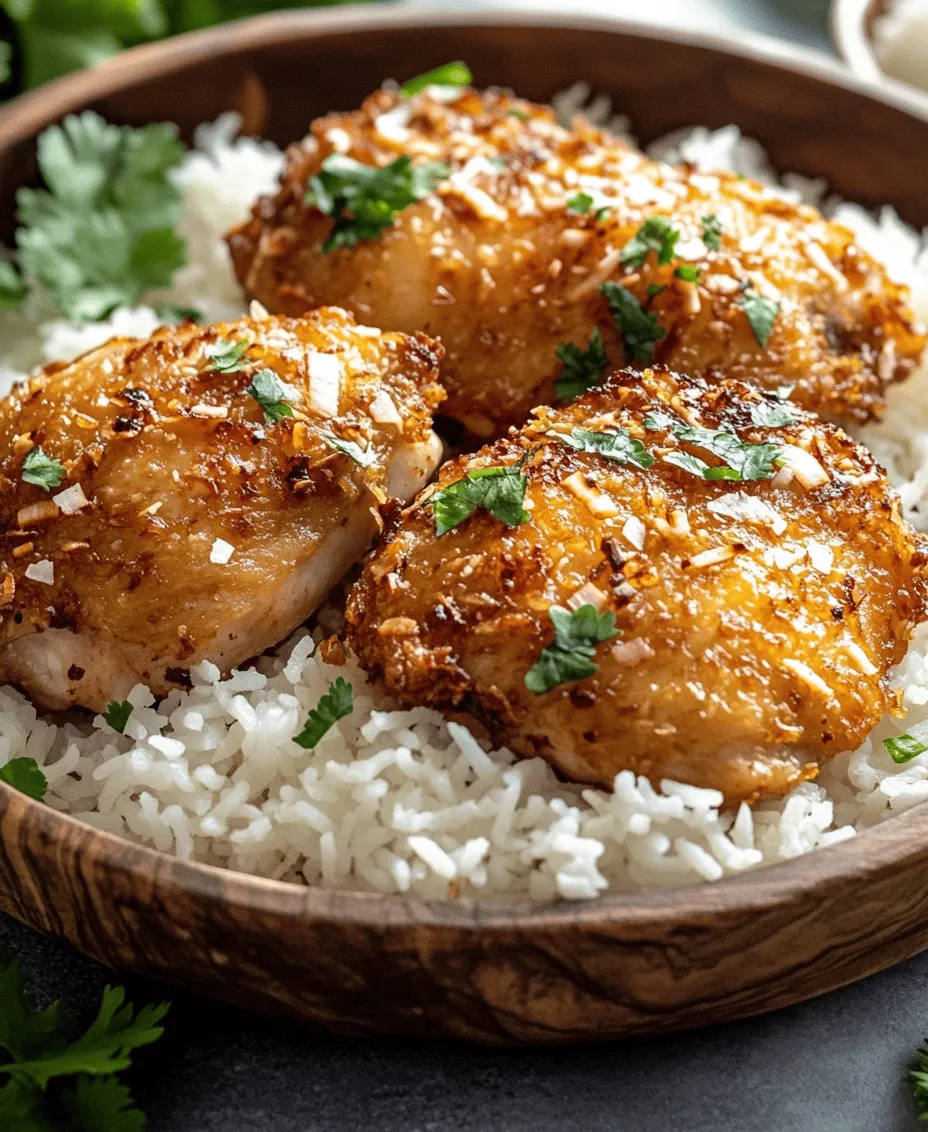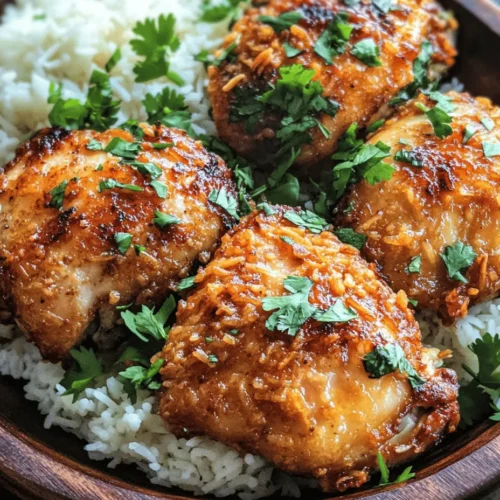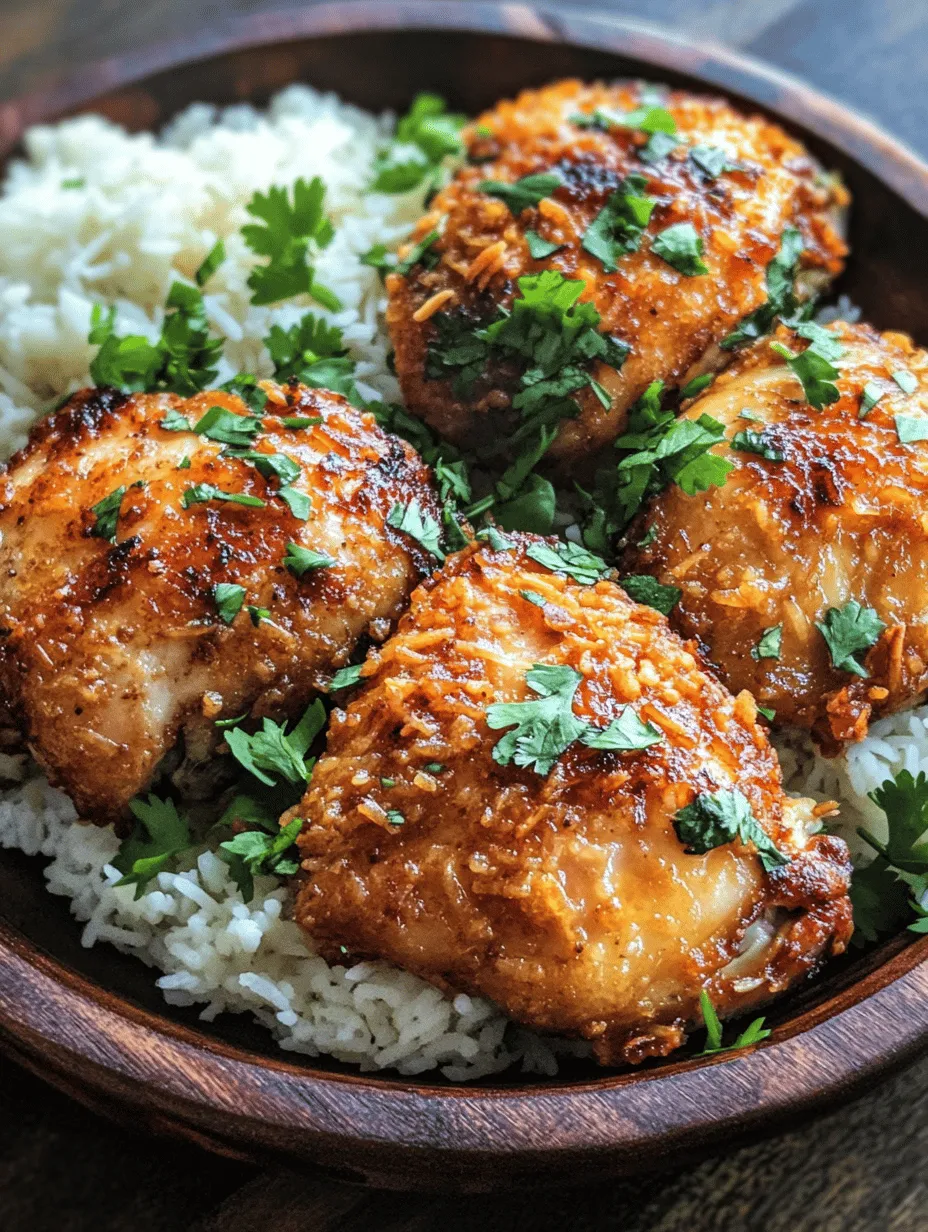Introduction
Welcome to a culinary journey that transports you straight to a sun-soaked tropical paradise! The Tropical Delight: Coconut Chicken recipe is not just a meal; it’s an experience that encapsulates the vibrant flavors of the tropics. Imagine the tender, succulent chicken infused with the creamy richness of coconut milk, complemented by the sweetness of shredded coconut. This dish is a celebration of two beloved ingredients that harmonize beautifully, creating a savory-sweet symphony that tantalizes your taste buds.
Coconut chicken is incredibly versatile, making it suitable for various occasions—from casual family dinners to festive gatherings. Its ease of preparation means you don’t have to be a seasoned chef to whip up this delightful dish. In just a few simple steps, you can impress your guests or simply treat yourself to a comforting meal that feels like a tropical getaway. Whether served with a side of jasmine rice, fresh salad, or tropical fruits, this recipe is sure to become a staple in your kitchen.
Understanding the Ingredients
To create the perfect Tropical Delight: Coconut Chicken, it’s essential to understand the role of each ingredient that contributes to its unique flavor profile and texture. Here’s a breakdown of the key components that make this dish truly special:
Chicken Thighs
The foundation of this dish is boneless, skinless chicken thighs. Unlike chicken breasts, thighs offer a richer flavor and remain juicy even after cooking. Their slightly higher fat content not only enhances the taste but also ensures that the chicken stays moist and tender. Additionally, thighs are more forgiving when it comes to cooking time, making them ideal for those who might be intimidated by the prospect of overcooking chicken.
Coconut Milk
Coconut milk is one of the star ingredients in this recipe, providing a creamy texture and a luxurious flavor. Made from the flesh of mature coconuts, it adds a subtle sweetness that perfectly complements the savory elements of the dish. The creaminess of coconut milk not only enriches the chicken but also acts as a natural sauce that binds all the flavors together. When selecting coconut milk, look for full-fat versions for the best richness, or opt for light coconut milk if you’re looking to reduce calories while still enjoying that tropical flavor.
Shredded Coconut
Shredded coconut brings in an additional layer of texture and sweetness. It can be sweetened or unsweetened, depending on your preference. When used in this recipe, shredded coconut adds a delightful crunch and a hint of tropical sweetness that enhances the overall experience. Toasting the shredded coconut before adding it to the dish can amplify its flavor, giving it a nutty aroma that complements the chicken beautifully.
Garlic and Ginger
Garlic and ginger are essential aromatics that elevate the dish’s flavor profile. Garlic adds a savory depth, while ginger provides a warm, zesty note that brightens the overall taste. Both ingredients are known for their health benefits, including anti-inflammatory properties and digestive support. When combined, they create a fragrant base that infuses the chicken with irresistible flavor.
Lime Juice
Lime juice plays a crucial role in balancing the richness of the coconut milk. Its acidity cuts through the creaminess, providing a fresh and zesty contrast that brightens the dish. Lime juice not only enhances the flavor but also adds a refreshing element that evokes the essence of tropical cuisine. Freshly squeezed lime juice is ideal, but bottled juice can serve as a convenient alternative in a pinch.
Coconut Oil
In this recipe, coconut oil serves as an ideal cooking fat that complements the coconut theme. Its high smoke point makes it perfect for sautéing the chicken, while imparting a subtle coconut flavor. Coconut oil is also celebrated for its health benefits, including its ability to promote heart health and support weight management. Using coconut oil in this recipe not only enhances the flavor but also aligns with the tropical theme.
Fresh Cilantro
To finish off this tropical delight, fresh cilantro adds a pop of color and a burst of freshness as a garnish. Its bright, herbaceous flavor complements the creaminess of the coconut and the richness of the chicken, providing a refreshing contrast. Cilantro is often used in tropical and Asian cuisines, making it a fitting addition to this dish. If you’re not a fan of cilantro, fresh parsley or green onions can be excellent alternatives.
Preparation Steps
Now that we’ve explored the key ingredients, let’s dive into the preparation steps that will lead you to a mouthwatering plate of Tropical Delight: Coconut Chicken. Proper preparation is crucial for ensuring that the flavors meld beautifully and that the chicken is cooked to perfection.
Marination Process
Marinating the chicken is one of the most important steps in this recipe, as it allows the flavors to penetrate the meat, resulting in a more flavorful dish. To start, prepare the marinade by combining coconut milk, minced garlic, grated ginger, lime juice, and a pinch of salt in a mixing bowl. Whisk the mixture until well combined, ensuring that the garlic and ginger are evenly distributed.
Add the boneless, skinless chicken thighs to the marinade, making sure each piece is thoroughly coated. Cover the bowl with plastic wrap or transfer the mixture to a resealable plastic bag, removing as much air as possible. For optimal flavor infusion, let the chicken marinate in the refrigerator for at least 30 minutes. While 30 minutes will suffice, marinating for several hours (or even overnight) will yield even better results, allowing the flavors to deepen.
Cooking the Chicken
Once your chicken has marinated, it’s time to cook it to perfection. Start by preheating a skillet over medium-high heat. Ensuring that the skillet is hot before adding the chicken is crucial for achieving a nice sear and locking in the juices. If you’re using a non-stick skillet, you may not need to add additional oil, but if you’re using a stainless steel or cast-iron skillet, consider adding a tablespoon of coconut oil to help prevent sticking.
While the skillet heats up, remove the chicken from the marinade, allowing any excess liquid to drip off. The marinade can be reserved for later use as a sauce if desired, but it’s important to bring it to a boil before using it to ensure food safety.
Next, dredge the chicken thighs in a mixture of shredded coconut and any remaining marinade to create a coating that adds both texture and flavor. This dredging technique is key for achieving that signature coconut crust that gives the dish its name.
Carefully place the coated chicken thighs in the hot skillet, ensuring not to overcrowd the pan. This allows for even cooking and a beautiful golden-brown crust. Cook the chicken for about 5-7 minutes on each side, or until the internal temperature reaches 165°F (75°C). You can use a meat thermometer to check for doneness, as this is the most reliable method for ensuring your chicken is perfectly cooked.
As the chicken cooks, the aroma of garlic, ginger, and coconut will fill your kitchen, creating an enticing atmosphere that anticipates the delicious meal to come. Once the chicken is cooked through, remove it from the skillet and let it rest for a few minutes before slicing. This resting period allows the juices to redistribute, ensuring that every bite is tender and juicy.
Serving Suggestions
With your Tropical Delight: Coconut Chicken perfectly cooked, it’s time to serve and enjoy! This dish pairs wonderfully with a variety of sides. Consider serving it over fluffy jasmine rice or coconut rice to enhance the tropical theme. Fresh, crisp salads with a citrus vinaigrette can also provide a refreshing contrast to the richness of the chicken.
For a complete tropical experience, you might add grilled pineapple or mango slices on the side. These fruits not only complement the flavors of the dish but also add a vibrant splash of color to your plate. Garnish with fresh cilantro for a final touch of brightness and flavor, and you have a meal that is not only delicious but visually stunning as well.
Stay tuned for the next part of this article, where we’ll delve deeper into expert tips for achieving the best results with your Tropical Delight: Coconut Chicken and address some common questions you may have about this delectable dish.

Ideal Accompaniments for Coconut Chicken
When serving your Tropical Delight Coconut Chicken, the right accompaniments can elevate the meal, enhancing the overall dining experience. Here are some ideal pairings that complement the dish beautifully:
Rice Varieties
1. Jasmine Rice: Known for its fragrant aroma and slightly sticky texture, jasmine rice is a classic pairing for coconut chicken. Its subtle floral notes mesh well with the tropical flavors of the coconut.
2. Basmati Rice: With its long grains and nutty flavor, basmati rice offers a delightful contrast to the creamy coconut sauce. It absorbs the flavors beautifully, making each bite a treat.
3. Coconut Rice: For a truly tropical experience, consider serving coconut chicken with coconut rice. This dish involves cooking rice in coconut milk instead of water, adding a rich, creamy texture and sweetness that complements the chicken perfectly.
Salad Pairings
Incorporating fresh salads adds a refreshing crunch and balances the richness of the coconut chicken. Here are a couple of suggestions:
– Fresh Greens Salad: A simple salad with mixed greens, cucumber, and a light vinaigrette can cut through the richness of the dish. The acidity from the dressing will enhance the overall flavor profile.
– Tropical Fruit Salad: A salad made with pineapple, mango, and papaya provides a fruity contrast that harmonizes with the coconut. Add a sprinkle of lime juice for brightness and a hint of mint for added freshness.
Presentation Tips for an Appealing Dish
Presentation is key to any dish, and Coconut Chicken is no exception. Here are some tips to make your dish visually appealing:
– Layer the Ingredients: Serve the chicken on a bed of rice and drizzle the coconut sauce over the top. This not only enhances flavor but also creates a beautiful contrast in colors.
– Add Color: Incorporate vibrant garnishes, such as fresh cilantro leaves or a sprinkle of toasted coconut flakes, to add visual interest.
– Serve in Bowls: Consider serving the dish in deep bowls rather than plates. This adds a touch of elegance and keeps the sauce from spilling over.
– Use Lime Wedges: Place lime wedges on the side for a pop of color and a burst of fresh flavor that guests can add to their taste.
Nutritional Information
Understanding the nutritional profile of your Coconut Chicken can help you enjoy this dish guilt-free. Here’s a breakdown:
Overview of the Dish’s Nutritional Profile
Coconut Chicken is not only delicious but can also be nutritious. The key ingredients include chicken, coconut milk, and a variety of spices, each contributing to the overall health benefits of the dish.
Caloric Content per Serving and Key Nutrients
A typical serving of Coconut Chicken (about 1 cup) contains approximately 400-500 calories, depending on the amount of coconut milk used and the size of the chicken pieces. Key nutrients include:
– Protein: Essential for muscle repair and growth, chicken is an excellent source of lean protein.
– Healthy Fats: Coconut milk is rich in medium-chain triglycerides (MCTs), which can provide a quick source of energy.
– Vitamins and Minerals: The dish is packed with vitamins A, C, and E, as well as minerals like magnesium and potassium, thanks to the spices and garnishes.
Health Benefits Associated with the Ingredients Used
– Coconut Milk: Contains lauric acid, which may have antimicrobial properties and support heart health.
– Chicken: A lean source of protein that is low in saturated fat, helping in weight management.
– Spices: Ingredients like garlic and ginger are known for their anti-inflammatory and antioxidant properties.
Discussion of Dietary Considerations
Coconut Chicken can easily cater to various dietary preferences:
– Gluten-Free: The recipe contains no gluten ingredients, making it suitable for those with gluten sensitivities or celiac disease.
– Dairy-Free: Coconut milk serves as a fantastic dairy substitute, ensuring the dish is safe for those who are lactose intolerant.
Cultural Significance of Coconut in Cuisine
Coconut holds a special place in many culinary traditions, especially in tropical regions. Its versatility is celebrated in a variety of dishes, making it a beloved ingredient across the globe.
Brief History and Cultural Relevance of Coconut in Tropical Dishes
Historically, coconuts have been used for centuries in tropical regions for their nutritional value and versatility. Coconuts are often referred to as the “tree of life” in many cultures due to their numerous uses, from food to cosmetics. In Southeast Asia and the Caribbean, coconut milk is a staple in various traditional dishes, highlighting its importance in local cuisines.
Exploration of Regional Variations of Coconut Chicken Recipes
Coconut Chicken recipes vary widely across different cultures. For example:
– Thai Coconut Chicken: Often incorporates lemongrass and lime leaves for a distinctly aromatic flavor.
– Caribbean Coconut Chicken: May include spices like allspice and nutmeg, giving it a warm, robust flavor profile.
These variations showcase the adaptability of coconut in cooking and its ability to absorb local flavors.
Connection to Comfort Food and Festive Occasions
Coconut-based dishes are often associated with comfort and celebration. In many cultures, coconut chicken is a dish served during family gatherings and festive occasions, symbolizing abundance and hospitality.
Variations and Customizations
One of the best things about Coconut Chicken is its adaptability. Here are some ideas for customizing the dish to suit different preferences:
Ideas for Adapting the Recipe to Different Dietary Preferences
– Alternative Proteins: For those looking to switch up the protein source, consider using shrimp or tofu. Tofu can absorb the flavors of the coconut sauce beautifully, making it a delicious vegan option. Shrimp cooks quickly and pairs wonderfully with the tropical flavors.
– Vegan or Vegetarian Adaptations: To make a vegan version, substitute chicken with chickpeas or tempeh and use vegetable broth instead of chicken broth in the sauce. The richness of coconut milk will still provide a satisfying experience.
– Flavor Variations: Personalize the dish by adding spices such as curry powder, turmeric, or even a hint of chili for heat. You can also experiment with adding vegetables like bell peppers or snap peas to the dish for added texture and nutrition.
Conclusion
Coconut Chicken is a delightful dish that transports your taste buds to a tropical paradise with every bite. The careful balance of flavors—savory chicken, creamy coconut, and vibrant spices—creates an unforgettable dining experience.
Whether you are enjoying it as a family meal or serving it to guests during a special occasion, this recipe embraces the essence of comfort food while introducing a unique tropical flair. The suggested accompaniments, presentation tips, and variations allow you to personalize the dish to fit your preferences and dietary needs.
As you explore the world of Coconut Chicken, let the flavors inspire you to experiment and enjoy this dish in your own way. It’s more than just a meal; it’s an invitation to savor the taste of the tropics and share it with loved ones. So gather your ingredients, follow the recipe, and get ready to indulge in a culinary adventure that is both satisfying and delicious.


